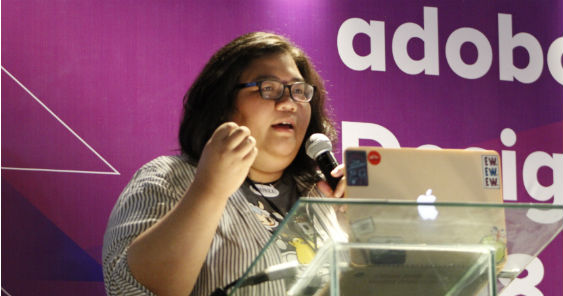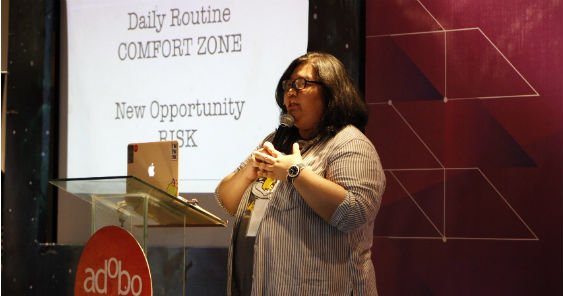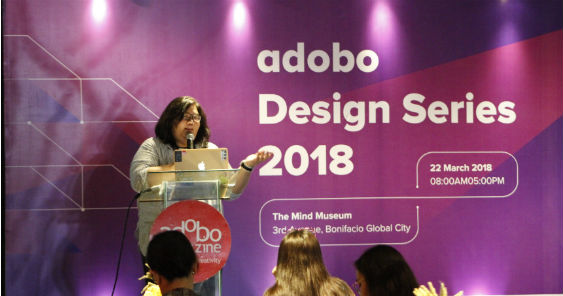By Nicai de Guzman
“We create 24/7, we think 24/7, even if we’re not in our work stations, in our offices, we think.”
This was how comic book illustrator and art director Tepai Pascual described the creative community that included her, during the adobo Design Series 2018 on March 22 at The Mind Museum.
True enough, the whole room was filled with nodding heads, all in agreement that creativity doesn’t choose a time or place.
“We are good at what we do, right? But most of the time, we look for something different,” Pascual added.
The artist, who is also the Co-Founder of Meganon Comics, shared the story of how she finally made the transition from being an advertising executive to a full-time comic book illustrator.
Step 1: Find out what you love to do and what you’re good at
Pascual was a senior in the University of the Philippines Diliman when she decided that she wanted to be a comic book artist.
“I really wanted to do it because I love doing it. I want to have a career with it, but knowing the state of comics in the Philippines, we have technically none,” she recalled.
“We don’t have a industry. We have a community but it’s small. That time, the last thing I wanted to be in was advertising,” she added.
An offer from a former professor led her to the world of advertising, where she spent around seven years learning the ropes and honing her craft.

“Advertising helped me to sharpen my craft in terms of idea building and art direction so it helped me through my comics survival mode and a bit of marketing,” Pascual added.
When Pascual was in advertising, she still wanted to do comics. Knowing what you really want to do is the first step, Pascual said.
“You ask yourself, what are you good at? And what do you love to do? What makes you happy? That’s what’s important. Because if you do something and you don’t love it you won’t do it again. You won’t have the patience for it. But if you love it, you’ll do everything for it,” she said.
“It starts with the thing you really want to do outside work. So, for example, you like food, so go eat food, go cook food, blog food, take photos of food,” she added.
Step 2: Do your own thing
Pascual made sure that despite working long hours, she made time for doing comic books.
“I suggest you do your own thing. Maybe you look food, or theater, film, arts and crafts. There are tons of things you can do outside your job. Probably some of it you already like or some of it you want to try,” Pascual advised the crowd in times of burnout.
She told the story of a friend who is also in the advertising industry who is also involved in theater, makeup. The same friend also owns a flower shop.
“How does he do it? Well, simply, you make time for it. You prioritize. Anyone can do anything when they set their minds to it,” she said.
This story is not uncommon among creatives. However, Pasual advises that one must balance it out. For example, if you’re still employed and you need to do tasks and papers, you still have to deliver.
“We creatives are sometimes deep in the creative process but we forget that there is another side to it. That’s where work-life balance comes in. You have to balance it out,” she stressed.
Despite its demands, Pascual also said that a hobby can become a business. This was how she started Meganon Comics, a publishing house for indie comic creators.
“I resigned from advertising in 2013 and I put up Meganon Comics… Now, we’re available in major book stores,” she said.
After she resigned, she also became a freelancer who does storyboards for TV and film directors. One of the projects she did was Erik Matti’s Metro Manila Film Festival entry, Seklusyon.
You are your own quality control. You’ve jumped off the cliff and survived. “
Step 3: Take that risk
If you’re a creative and you follow through with making a business out of your hobby, there is a fear or risk of not selling, Pascual said. Getting over that fear of failure is essential.
“How will you learn if you don’t fail, right?” she asked.
Back in 2008, when Komikon was still being held in Bahay ng Alumni inside UP Diliman, Pascual had to photocopy just 30 copies of one of her earlier works, Mark 9 Verse 47. The first version of Maktan 1521 was just 20 pages long and in black in white.

She later tried offset printing but it was difficult because printing businesses require artists to print at least 500 copies.
“If you’re an indie how are you going to sell all of those especially if you only have an event for distribution point?”
After some years, she found the courage to submit Maktan 1521 to publisher Visprint, the same publishing house of Manix Abrera’s Kikomachine, Budjette Tan’s Trese, and Carlo Vergara’s Zsazsa ZaturnNah. After some months and a bit of a mix up with the publishing house, she got officially printed and since then, she made it into her crusade to give other comic book illustrators like her a chance.
“Some of us may be doing it for 10, 20 years and we look for something new just to excite us more because we’re kind of having a boring life every once in a while. Our daily life becomes a cycle,” she said.
It may be burning out or finding an outlet that may spark the want in creatives to do what they really want.
“When you have your daily routine, we’re in that comfort zone wherein we do things every day and when this opportunity comes for us, it’s also for us to take that risk so it’s up to us if we are willing to take that risk or just be comfortable,” Pascual said.
“Finding some inspiration, knowing what you want to do, learning how to do it, taking risks and opportunities. So maybe stepping out of your comfort zone is worth it.”








